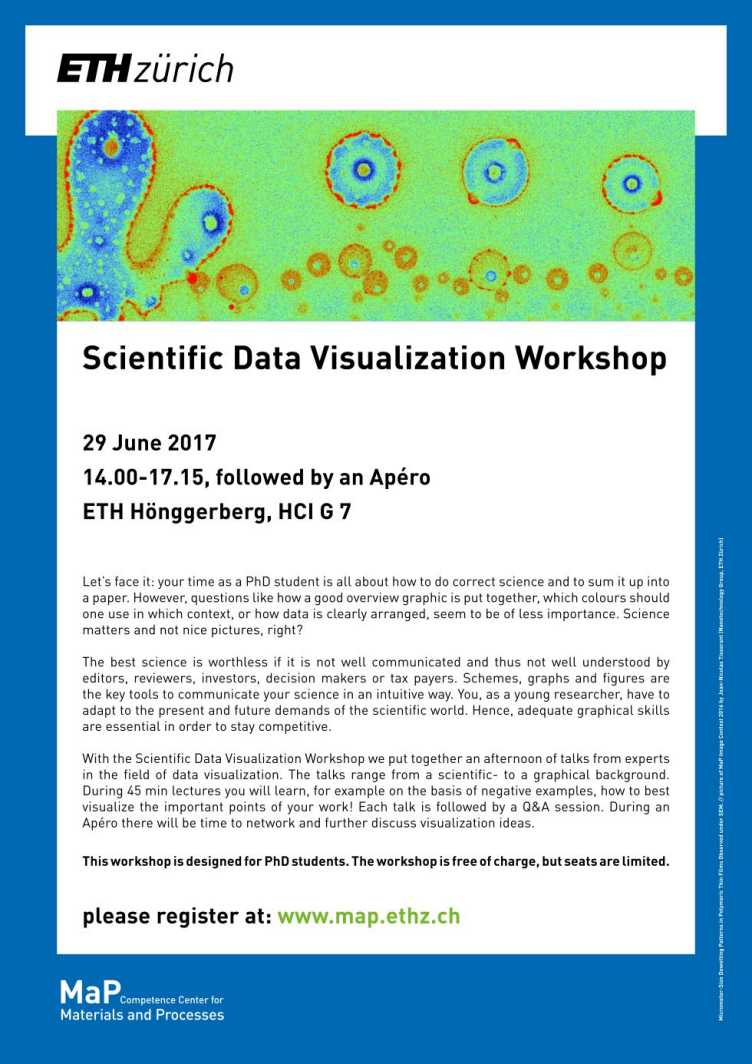Scientific Data Visualization
Afternoon workshop organised by PhDs for PhDs.
Scientific Data Visualization Workshop

29 June 2017
14.00-17.15, followed by an Apéro
ETH Hönggerberg, HCI G 7
This workshop is designed for PhD students. The workshop is free of charge, but the seats are limited.
Many thanks to Kirstin Casdorff, Sanja Kostic & Christian Goldhahn of the MaP group Wood Materials Science (D-BAUG) for the initiative!
Let’s face it: your time as a PhD student is all about how to do correct science and to sum it up into a paper. However, questions like how a good overview graphic is put together, which colours should one use in which context, or how data is clearly arranged, seem to be of less importance. Science matters and not nice pictures, right?
The best science is worthless if it is not well communicated and thus not well understood by editors, reviewers, investors, decision makers or tax payers. Schemes, graphs and figures are the key tools to communicate your science in an intuitive way. You, as a young researcher, have to adapt to the present and future demands of the scientific world. Hence, adequate graphical skills are essential in order to stay competitive.
With the Scientific Data Visualization Workshop we put together an afternoon of talks from experts in the field of data visualization. The talks range from a scientific- to a graphical background. During 45 min lectures you will learn, for example on the basis of negative examples, how to best visualize the important points of your work! Each talk is followed by a Q&A session. During an Apéro there will be time to network and further discuss visualization ideas.
Abstracts of Speakers
After months of measurements and countless hours of data cleaning and processing, you got exciting results that point towards entirely new scientific insights. Graphing that data occurs to you as an afterthought when writing the paper or putting together the poster or slide stack. Nothing complicated, just a few mouse clicks in your favorite spreadsheet software and done! Good enough.
Or is it? Is that diagram really expressive of your data – i.e., a true and honest depiction of your data and only your data? Could it be misread by showing features that are not actually in the data? Could critical viewers even come to the conclusion that you wanted to mislead them? Would there be a way for these critics to check your diagram for plausibility, maybe even reproduce it? And if it is a valid representation of your data, is it also effective for highlighting your results – i.e., does it convey what you want to show about your data? Can viewers easily pick up on the points you’re trying to make with that graphic? Or do you need a long figure caption to explain how to read your diagram, what can be observed in it, and why this is important?
This talk will provide you with a basic understanding of the Do’s and Don’ts of data visualization – chart types, scales, colors, labels, legends, etc. It will be accompanied by a multitude of examples showing best and worst case data visualizations, so that you get a concrete idea of the pitfalls to look for in your diagrams, as well as when reviewing the work of others, and how to fix them.
Note: You can submit your diagram, figure, or chart to the speaker for a chance of it being discussed anonymously as one of the examples in the talk. To get your graphic considered simply email it in PNG or PDF format together with a brief description to by 16 June 2017.

Dr. Hans-Jörg Schulz received his PhD from the University of Rostock, Germany in 2010 with a thesis on “Explorative Graph Visualization”. He has since worked in the areas of Visual Analytics and Information Visualization, with extended research stays at IBM Research in the US, TU Graz in Austria, and Fraunhofer IGD in Germany. He is currently working as a Senior Researcher at the external page Institute of Computer Science at the University of Rostock, while pursuing his research interests in general visualization concepts and specific visualization techniques for climate research and the life sciences.
History teaches us one very harsh truth: It doesn’t matter how hard you have worked and how profoundly great your ideas are. If you can’t sell it, it’s basically useless. Throughout all the different markets it’s plain to see: Visual appeal and comprehensibility play an imperative part in successfully selling ideas.
But how is it done? Way too many people have the misconception that creating something which is visually appealing requires so-called «talent», meaning some kind of hard to define and even harder to gain ability which you’re either born with or not. The uplifting truth is: That’s not true. In fact, there are some very simple rules that anyone can learn and apply.
In this talk, I’d like to introduce you to the most important rules (use of graphic elements, colours, fonts and space) and a simple as well as time-efficient process, which will allow you to create appealing and convincing graphics – each and every time. After having answered some key questions, you will start the actual creation steps, which will end with the most important yet underrated process: reduction. This workshop and some practice will help you realise that there’s actually very little «magic» in everyday graphic design and that you can do this!
Stephan Bretscher received a classical education in graphic design during his apprenticeship as Polygraph at the Ringier Holding. Right after that, he found his first job as a graphic designer in an advertising agency in 2007. After nine years of developing and finishing creative projects for multitudes of clients – from small ads for local businesses to complex campaigns for international players, he is now working for The Adecco Group Switzerland as visual authority for four major brands.